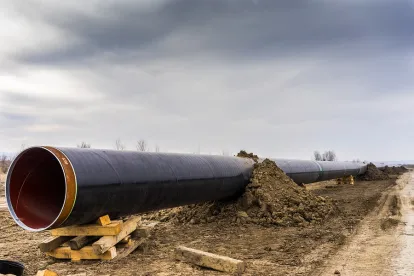PHMSA releases Advisory Bulletin on methane emissions. TSA issues Security Directive to pipelines deemed to be critical facilities. PHMSA denies petition for reconsideration of Gas Pipeline Regulatory Reform final rule. PHMSA requests comments on the renewal of several information collection requests. Status of PHMSA Rulemakings.
PHMSA Releases Advisory Bulletin on Methane Emissions
On June 7, the Pipeline and Hazardous Materials Safety Administration (PHMSA) issued an Advisory Bulletin reminding owners and operators of gas pipeline facilities that Section 114(b) of the “Protecting our Infrastructure of Pipelines and Enhancing Safety Act of 2020” (PIPES Act 2020) contains a self-executing provision requiring operators of gas distribution, transmission and gathering pipeline facilities to update their inspection and operation and maintenance (O&M) plans to address eliminating hazardous leaks and minimizing releases of natural gas from their pipeline facilities and replacing or remediating pipelines that are known to leak because of their material, design, or past O&M history.
Operators must comply with Section 114(b) by December 27, 2021. As required under the PIPES Act of 2020, PHMSA and state regulators will inspect operators’ compliance with these requirements during 2022.
The Advisory Bulletin included the following considerations for operators when updating their O&M plans to comply with Section 114(b):
Plans must be updated to include sufficient detail to address the elimination of hazardous leaks and minimization of releases of natural gas from the operators’ pipeline facilities. Plans must include steps taken to prevent and mitigate both unintentional, fugitive emissions, which includes leaks from pipelines, flanges, valves, meter sets, or other equipment, as well as intentional, vented emissions. Sources of vented emissions include pneumatic device bleeds, blowdowns, incomplete combustion, or overpressure protection venting.
Plans must adequately address the replacement or remediation of pipelines that are known to leak based on material (including cast iron, unprotected steel, wrought iron, and historic plastics with known issues), design, or past O&M history of the pipeline.
Operators must also carry out a current, written O&M plan to address public safety and protection of the environment that contributes to the elimination of hazardous leaks and minimizing releases of natural gas from pipeline facilities.
TSA Issues Security Directive to Pipelines Deemed to be Critical Facilities
On May 26, the Transportation Security Administration (TSA) released Security Directive Pipeline-2021-01 directing owners and operators of hazardous liquid and natural gas pipelines and liquefied natural gas (LNG) facilities identified as “critical” by TSA to take specified actions related to pipeline cybersecurity. The Security Directive was issued following the cybersecurity ransomware attack on Colonial Pipeline Company, which caused the pipeline to stop operations for several days. The Security Directive became effective May 28.
The Security Directive is considered the first step in establishing a more prescriptive regulatory scheme and notably combines the resources of both TSA and the Cybersecurity and Infrastructure Security Agency (CISA) within the Department of Homeland Security. Owners and operators of facilities deemed to be critical must take the following actions:
-
Identify a corporate-level Cybersecurity Coordinator and alternative Cybersecurity Coordinator by June 4, 2021. The Cybersecurity Coordinator(s) will serve as the primary contact for cyber-related intelligence information and cybersecurity-related activities and communications with TSA and CISA, coordinate internal cyber and related security practices and procedures, work with appropriate law enforcement and emergency response agencies, and be accessible to TSA and CISA 24 hours a day, 7 days a week.
-
Report cybersecurity incidents to CISA. Cybersecurity incidents include unauthorized access of information technology (IT) or operational technology (OT) systems; discovery of malicious software on IT or OT systems; activity resulting in a denial of service to any IT or OT system; physical attack against the owner/operator’s network infrastructure, such as deliberate damage to communication lines; and any other cybersecurity incident that results in operational disruption to IT or OT systems or other aspects of the pipeline system or facility, or otherwise could cause operational disruption.
-
Report the information described in (2) above to CISA within 12 hours. The report must contain certain information specified in the Security Directive. If all required information is not available within 12 hours, owner/operators must submit an initial report within the specified time and file supplemental reports.
-
Perform a Vulnerability Assessment based on Section 7 of TSA’s 2021 Pipeline Security Guidelines. Owner/operators must assess whether current practices and activities to address cyber risks to IT and OT systems align with the Guidelines; identify gaps; identify remediation measures to fill the gaps and a timeline for implementing the measures; and provide a report to TSA and CISA by June 27.
-
Confirm receipt of the Security Directive and disseminate information and measures contained in the Security Directive to corporate senior management, security management representatives, and personnel with compliance responsibilities.
PHMSA Denies Petition for Reconsideration of Gas Pipeline Regulatory Reform Final Rule
On May 20, PHMSA denied the Pipeline Safety Trust’s (PST) petition for reconsideration of the Gas Pipeline Regulatory Reform final rule. The final rule amended §§ 192.153(e)(1) and 192.619(a)(2)(ii) of PHMSA’s regulations to clarify that a fabricated unit or pressure vessel installed between July 14, 2004 and March 12, 2021 (the effective date of the final rule) using a test pressure of 1.3 times the maximum allowable operating pressure (MAOP) consistent with the hydrostatic pressure test factors of ASME Boiler and Pressure Vessel Code (BPVC), Section VIII, Division 1, is not subject to the strength testing requirements of § 192.505(a) or (b). The final rule explained that this revision ensured that an operator of a pressure vessel designed and hydrostatically tested in accordance with the 2001 edition of ASME BPVC after PHMSA incorporated into it the pipeline safety regulations complies with the regulations.
The PST alleged that allowing existing pressure vessels (such as compressor stations and tanks) to be tested to a lower initial pressure test factor than is specified in § 192.505 violates the nonapplication clause of § 60104(b) of the Pipeline Safety Laws, which prohibits applying a “design, installation, construction, initial inspection, or initial testing standard” to a pipeline facility that is in existence when the standard is adopted.
PHMSA rejected this interpretation of § 60104(b) finding that: (1) § 60104(b) does not apply because the final rule did not impose a new initial testing requirement on existing pipeline facilities; (2) the final rule’s amendment to § 192.153 is supported by an independent study by the Oak Ridge National Laboratories and eliminated a regulatory inconsistency or ambiguity created when PHMSA adopted the 2001 edition of the ASME BPVC that contained test factor requirements different from the test factor stated in existing section 192.505(b); (3) PST acknowledged that the final rule does not negatively affect pipeline safety because PST’s proposed alternative remedies, including issuing a stay of enforcement or requiring special permits, would allow operators to continue operating pressure vessels that were tested using the 1.3 test factor; and (4) amending the regulations to allow the 1.3 test factor reflects a better regulatory policy than issuing a perpetual stay of enforcement or requiring waivers of the regulations.
Status of PHMSA Rulemakings
The chart below shows the status of PHMSA’s pending pipeline safety rulemakings as reflected in PHMSA’s May 14 PIPES Act 2020 Web Chart, which is mandated in the PIPES Act 2020, and the Office of Management and Budget’s (OMB) Office of Information and Regulatory Affairs (OIRA) Fall 2020 Unified Agenda. New information is reflected in bold.
Pending Final Rules
|
Proceeding |
PHMSA Estimated Publication |
OIRA Estimated Publication |
|
Class Location Requirements |
March 21, 2023 |
November 2020 |
|
Coastal Ecological Unusually Sensitive Areas (Changed from Advanced Notice of Proposed Rulemaking to Interim Final Rule) |
November 5, 2021 |
Listed as an ANPRM |
|
Liquid Pipeline Regulatory Reform |
Not Listed |
April 2021 |
|
Periodic Standards Update Rule (2137-AF13) |
Not Listed |
Not Provided |
|
Pipeline Rupture Detection and Mitigation for Onshore Populated and High Consequence Areas |
October 29, 2021 |
April 2021 |
|
Safety of Gas Gathering Pipelines |
November 30, 2021 |
April 2021 |
|
Safety of Gas Transmission Pipelines: Discretionary Integrity Management Improvements |
November 30, 2021 |
April 2021 |
Pending Notices of Proposed Rulemakings
|
Proceeding |
PHMSA Estimated Publication |
OIRA Estimated Publication |
|
Amendments to LNG Facilities |
September 9, 2022 |
June 2021 |
|
Gas Pipeline Leak Detection |
May 27, 2022 |
Not Listed |
|
Liquid Pipeline Regulatory Reform |
Not Listed |
April 2021 |
|
Periodic Standards Update Rule (2137-AF13) |
NPRM Issued January 15, 2021 |
|
|
Periodic Standards Update II (2137-AF48) |
Not Listed |
April 2021 |
|
Pipeline Operational Status |
April 14, 2023 |
Not Listed |
|
Repair Criteria for Hazardous Liquid Pipelines |
Not Listed |
July 2021 |
|
Safety of Gas Distribution Pipelines |
July 5, 2022 |
Not Listed |
Other Updates from PHMSA
PHMSA requests comments on the renewal of several information collection requests.
On May 25, PHMSA issued a notice and request for comments announcing that the agency is forwarding to OMB several existing information collections requests (ICR) for renewal. Comments are due June 24. The ICRs require pipeline operators to maintain records under the following pipeline safety regulations: (1) Post-Accident Drug Testing for Pipeline Operators; (2) Customer-Owned Service Lines (requiring operators to maintain records of written notices to customers regarding the proper maintenance of customer-owned buried service lines); (3) Public Awareness Program; (4) Recordkeeping Requirements for LNG facilities; (5) Qualification of Pipeline Safety Training; (6) Periodic Underwater Inspection and Notification of Abandoned Underwater Pipelines; and (7) Recordkeeping for Underground Natural Gas Storage Facilities.
PHMSA provides report to Congress on staffing and hiring plans.
On May 28, PHMSA submitted a report to Congress regarding Fiscal Year (FY) 2021 staffing and hiring plans and actual turnover and hiring in FY 2020 for the Office of Pipeline Safety (OPS). The report states that PHMSA continues to work to achieve its full employment goal of 308 Pipeline Safety personnel, noting that pipeline safety inspectors, who typically are engineers, are difficult to recruit and retain because of the high demand for their skills in the regulated industry. The report states that, as of September 30, 2020, OPS had filled 99% of its positions, gaining a net of 17 pipeline safety employees and decreasing turnover in FY 2020.







 />i
/>i
